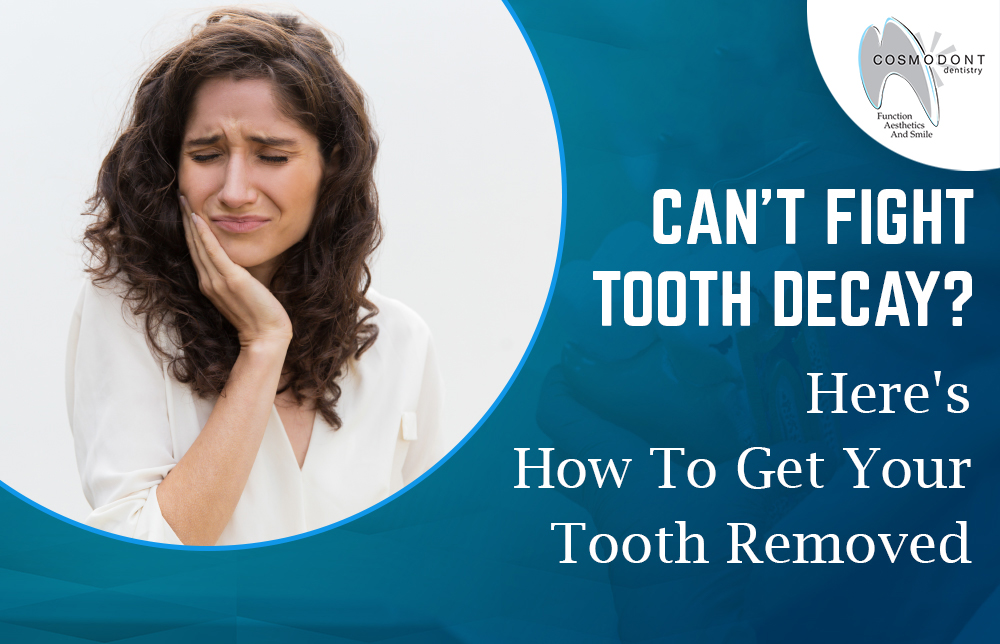Can't Fight Tooth Decay? Here's How to Get Your Tooth Removed
Tooth decay is a common problem that can lead to serious consequences if left untreated. For some, however, the damage done by tooth decay may require more drastic measures – like tooth extraction. Tooth extraction is not an ideal solution, but it may be necessary in certain cases. If you or someone you know is considering getting a tooth removed, this article will provide an overview of what you need to know.

We’ll cover the causes of tooth decay, the process of removing a tooth, and the post-extraction care required to ensure proper healing. Read on for all the information you need to make an informed decision about whether or not to have your tooth extracted.
Tooth decay is the process of your tooth breaking down. It can happen when the enamel, or the outer layer of your tooth, starts to wear away. This can be from brushing too hard, eating acidic foods, or not taking care of your teeth properly. Once the enamel is gone, the next layer of your tooth, called dentin, starts to break down. This can lead to a hole in your tooth, called a cavity. If you don’t treat a cavity, it will continue to get larger and eventually reach the nerve of your tooth. This can cause pain, infection, and even death if not treated quickly enough.
- Causes of tooth decay
There are many different causes of tooth decay. The most common cause is poor oral hygiene. This can be caused by not brushing your teeth regularly, not flossing, or not using mouthwash. Other causes of tooth decay include eating sugary or acidic foods, drinking carbonated beverages, smoking, and dry mouth.
- How to remove a tooth
There are a few different ways that teeth can be removed, but the most common is through extraction. This is a process where the tooth is removed from the socket in the bone. Local anesthesia is used to numb the area around the tooth, and sometimes Sedation Dentistry may be used as well.
The first step in extraction is to loosen the tooth with an instrument called an elevator. Then, forceps are used to remove the tooth. The entire process usually takes less than 30 minutes.
After the tooth has been removed, you will have some bleeding. This is normal and will stop on its own. A gauze pad will be placed over the site to help control the bleeding. You may also be given a prescription for pain medication.
It’s important to take care of your mouth after an extraction. Rinse your mouth with warm salt water 3-4 times a day and avoid smoking or using straws for at least 24 hours.
- Tooth Extraction: Aftercare & Recovery
After you have a tooth extracted, it’s important to take care of yourself so that you can heal properly. Here are some aftercare tips to follow:
- Brush your teeth gently and avoid using a toothbrush with hard bristles.
- Rinse your mouth regularly with warm salt water.
- Ice the affected area for 20 minutes at a time, several times a day.
- Eat soft foods and avoid hot or cold drinks for the first 24 hours.
- Take over-the-counter pain medication as needed.
If you experience any complications, such as excessive bleeding or pain, be sure to contact your dentist right away. With proper aftercare, most people recover from a tooth extraction without any problems.
- Benefits of Tooth Extraction
There are a few benefits of tooth extraction, even though it may seem like a last resort. First, it can relieve pain that is caused by a tooth that is severely decayed or infected. Secondly, it can help to prevent the spread of infection to other teeth or to other parts of the body. Thirdly, it can improve your oral health overall by making it easier to brush and floss your teeth properly. Finally, it can give you a more aesthetically pleasing smile by getting rid of any visible signs of decay or damage.
- How Cosmodont can help!
If you’re looking for help with Tooth Extraction in Toronto, Brampton & Mississauga, Cosmodont can help. We offer a wide range of dental services, including teeth removal, and we can help you get your tooth removed quickly and safely. We know that losing a tooth can be a difficult experience, but we’re here to help you through it. We’ll work with you to find the best solution for your individual case, and we’ll make sure that you’re comfortable throughout the entire process. Contact us today to schedule a consultation.
